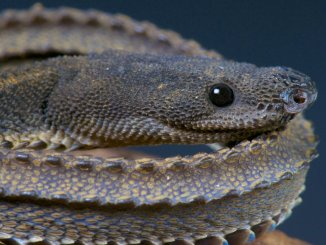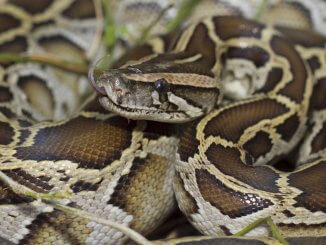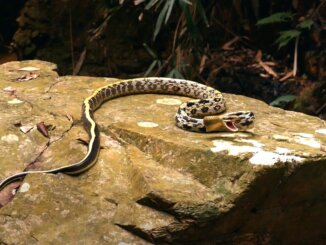The Angolan python is a medium-sized constrictor native to Southern Africa.
This rare species of python is easily recognized by its large eyes, bead-like head scales, and cream-colored bands or spots.
Angolan pythons are relatively easy to care for, as they require a consistent and straightforward routine.
They also have quite a unique personality for pythons and are not as shy as other breeds.
If you are looking to care for a rare and exciting breed of snake, then the Angolan python could be a great option. Here is everything you need to know about caring for this species of snake.
Angolan Python Overview
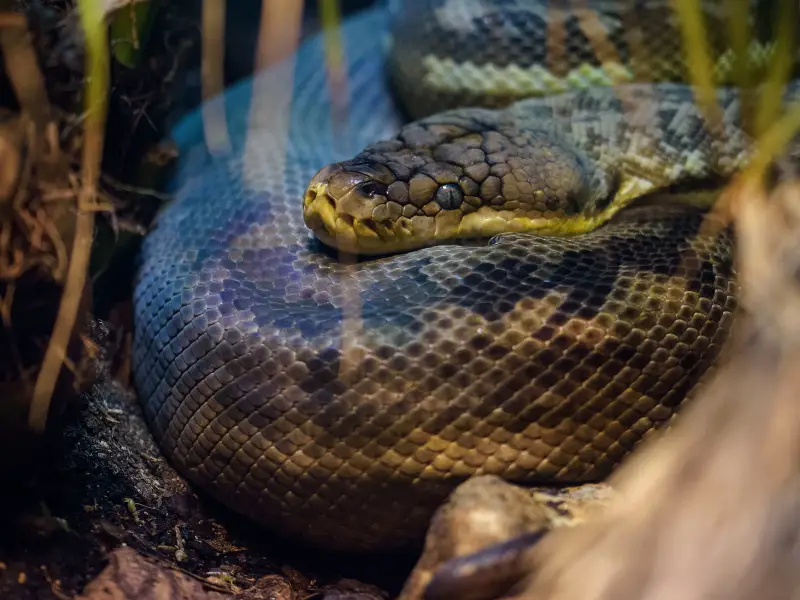
| Common name | Angolan python, Anchieta’s dwarf python |
| Scientific name | Python anchietae |
| Natural habitat | Endemic to Southern Africa |
| Adult size | 3 to 6 feet |
| Average lifespan | 30 years or more |
| Diet | Carnivores, praying on small mammals, birds, and amphibians |
| Housing | Terrarium at least 2ft x 2ft x 22ft for a single python |
| Experience | Beginner |
Origin
The Angolan python (python anchietae) is found in certain areas of Southern Africa, namely Southern Angola and Northern Namibia.
Typically, these snakes are found around Catumbella, near Lobito, in Angola. However, finding an Angolan python in the wild is rare.
The natural habitat of an Angolan python includes rocky outcrops, rocky deserts, or open bush or grassland areas that are littered with rocks.
These snakes find shelter in small caves, crevices, and overhangs.
Like all pythons, the Angolan python is non-venomous. These snakes are highly sought-after and are often compared to the ball python.
This is because both reptiles have very similar temperaments and care requirements.
The long-lasting civil war in Angola made it rare to find these pythons in captivity.
Although the war is over, the landmine-scattered fields and forests of this snake’s natural habitat meant few people would risk going out to catch these snakes.
Even long after the war, this has resulted in a few of these snakes being caught and bred.
This python’s arid and remote natural landscape also tends to be inaccessible, which contributes to the rarity of this species.
Appearance And Behavior
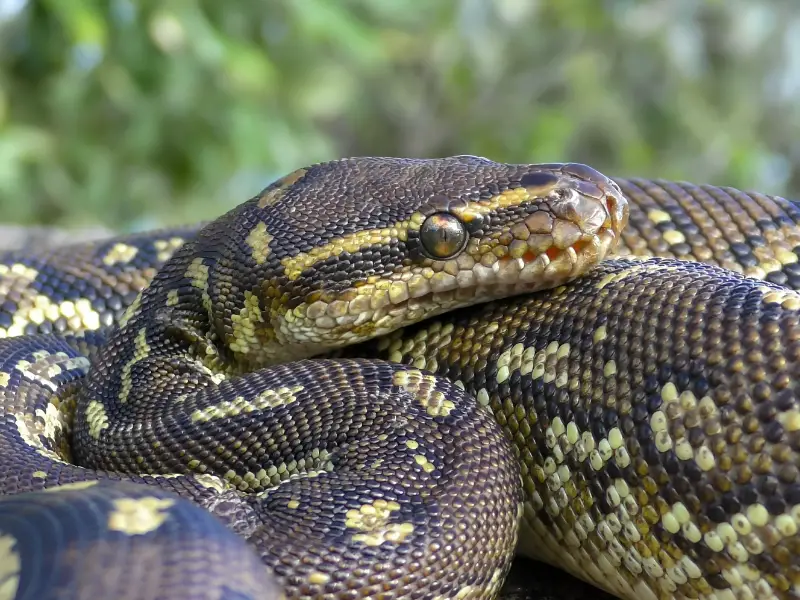
You can distinguish these pythons by their rust, brown, or nearly black coloring. Across the body of this snake, you’ll find white and cream-colored bands and spots.
These bands or spots are often marked with black outlines. The python has a yellow-colored underbelly.
Another tell-tale feature of an Angolan python is its head scales, which resemble beads. This is the only species of python with these distinctive scales.
These snakes have smooth dorsal scales, usually arranged in rows of 57 to 61.
As a result of the arid habitat of the Angolan python, they are bumpy to the touch, while most other snakes are smooth.
This is a common adaptation of reptiles living in arid environments as it helps them to catch and collect more moisture from condensation and rain.
These pythons have large black eyes on the sides of their heads and look very similar to a ball python. However, the Angolan python has five heat-sensing pits on each side of the head, while the ball python only has four.
Males typically have thicker, fatter tails than females and can also be identified by a slight bulge after the cloaca.
Size And Lifespan
Angolan pythons are medium-sized snakes. As adults, they will grow to about 5 or 6 feet in length. This is relatively small for a python. However, don’t let the size fool you – these snakes are strong!
When properly taken care of, these pythons will live for around 30 years. However, they are known to live longer than this under the right circumstances and with the right care.
Temperament
Angolan pythons are bold and more interactive than ball pythons and enjoy spending time exploring. This is why it’s important to have a large enclosure.
They also enjoy spending time outside their enclosures and discovering their surroundings.
These pythons naturally forage for food at night to escape the heat of their natural habitat. So, you can expect more activity from these snakes after dark.
One of the reasons for their large eyes is so that they can see better at night!
Angolan pythons should be housed separately from one another, with one snake per enclosure.
While there are stories of these snakes living in a single enclosure in harmony, they prefer solitude.
Once they are adults, you can house males and females together. This combats the risk of these snakes mating too young.
This species of python is non-venomous and can be handled. However, handle them in moderation.
They do not naturally require social interaction, and excessive handling can be stressful for them.
Housing Angolan Pythons
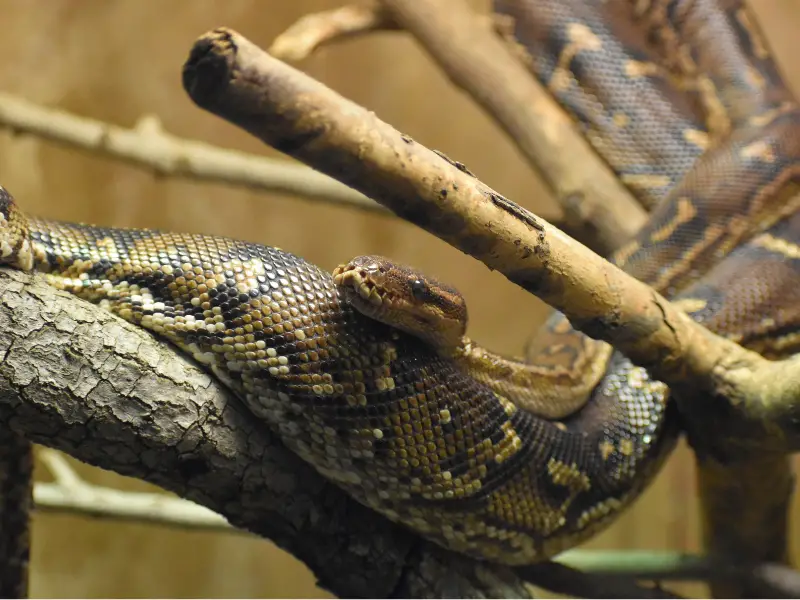
While Angolan pythons are smaller than other pythons, they’re still sizeable! So, they require large enclosures.
They’re known to be more active than other python species, so make sure your enclosure has plenty of space and stimulation for them
You can keep these pythons in a strong terrarium. It’s best to keep their housing fairly simple, as this best matches their natural habitat. It also lets you keep a closer eye on them.
The snake’s natural habitat includes desert and arid climates, so you can keep foliage and plants to a minimum.
Adding flat slate rocks and keeping their enclosure minimally decorated can help to make it feel more natural.
Enclosure Size
A large enclosure is necessary for housing an Angolan python.
You can keep juveniles in terrariums that are roughly 18 x 12 inches. But, when they outgrow their enclosures, you’ll need to move them to larger tanks that are suitable for adults. These terrariums should be around 3ft x 1.5ft x 1.5ft or 2ft x 2ft x 2ft.
The larger the better though as these snakes love space!
Lighting
Angolan pythons come from warm and dry climates so try to recreate this in your snake’s enclosure.
Most enclosures don’t require extra heat lights for a healthy environment. However, this depends on the surrounding temperature.
Household lights are generally fine for lighting and heating a python’s enclosure. Ambient room light is appropriate.
Whatever type of lighting you choose, make sure that you turn it off at night and on during the day.
This day and night light cycle is important for mimicking your python’s natural environment.
Ensure that the enclosure is at the right temperature as well. If it needs extra heat, you can install a basking lamp. However, many python owners do not use this.
No special UVB lights are required for this species, as you would typically find them living in caves and rocky crevices in their natural environment.
However, you can add UVB lighting to your python’s enclosure without causing harm. If you keep your snake in a room that doesn’t get much light, a UVB lamp may be useful.
Temperature And Humidity
Because these pythons are native to desert and arid climates, they are used to warmer days and colder nights.
Because of this, your Angolan python’s enclosure must have a hot spot and a cool spot. This difference in temperature helps with thermoregulation.
Your python’s hot spot should be around 90°F and the cold spot should be around 75°F. This is the ideal thermal gradient for these snakes and you can achieve this by using a heat source like a ceramic bulb or an under-tank heating mat.
Whatever heat sources you use, be sure to position all heating elements on one side of the enclosure.
This is necessary for your python to be able to regulate its temperature based on the heat differences.
Always pay attention to where in the enclosure your python spends more time, as you may need to adjust the heat levels.
Ensure that your heat sources are connected to a reliable thermostat so that you can monitor the temperature of the enclosure.
A humidity level of 50% is recommended for an Angolan python enclosure. To achieve this, you simply need to place a source of water in the enclosure.
You can use a hygrometer to measure the humidity levels in the enclosure.
Ensure the enclosure has plenty of air flow. This is especially important if you live in a very humid area.
In this case, you may need to dehumidify the enclosure. You can use a dehumidifier if humidity levels are too high.
While these snakes come from relatively low-humidity environments, they do tend to spend their time hiding in caves or rock crevices, which have higher levels of humidity.
So, it is important to include a humid hide inside your reptile’s enclosure to mimic its natural hiding spots.
Substrate And Decoration
To best mimic the Angolan python’s natural habitat, it’s important to use a relatively simple substrate.
These snakes do not need highly detailed environments. A more basic substrate will keep them happy while also being easier to clean.
Use a very basic substrate like paper towels or newspaper. This is easy to clean as you simply need to replace them.
You can also go for a more natural substrate, like Eco Earth, coco fiber, cork bark, or Aspen bedding. This helps you achieve a more natural look in the enclosure. You can just spot-clean this bedding.
Make sure to include a humid hide for your snake. You should have one on each side of the enclosure. A humid hide can include some damp moss for extra humidity.
Adding a reptile hide is especially important if you’re using a glass enclosure.
In terms of decorations, you don’t need to include much for these pythons. Adding some rocks is a good idea, but there’s no need for foliage in the enclosure.
Other than a large bowl of water and the hides, these snakes can thrive in relatively simple enclosures.
However, you can create a more interesting setup for these snakes. Including rocky shelves and arid plants can work well.
Ensure that any rocks or decorations in the enclosure are firmly rooted in place. These snakes are strong and can easily break apart a terrarium. This can harm your snake, so be cautious!
Cleaning
Spot-clean your enclosure’s substrate whenever your python defecates. Regular spot checks are important.
Beyond this, you need to replace the substrate at least once per month. When doing this, be sure to disinfect the entire enclosure area before adding the new substrate.
You can use hot soapy water to do this. Regular dish soap works perfectly, but try to avoid any heavily fragranced soaps or detergents.
You can also just use clean, hot water and plenty of elbow grease. Make sure you also change the water source in the enclosure regularly to keep it clean.
When changing the substrate, pick up the python and move it to its ‘backup home’ or another enclosure while you clean.
Angolan Python Care
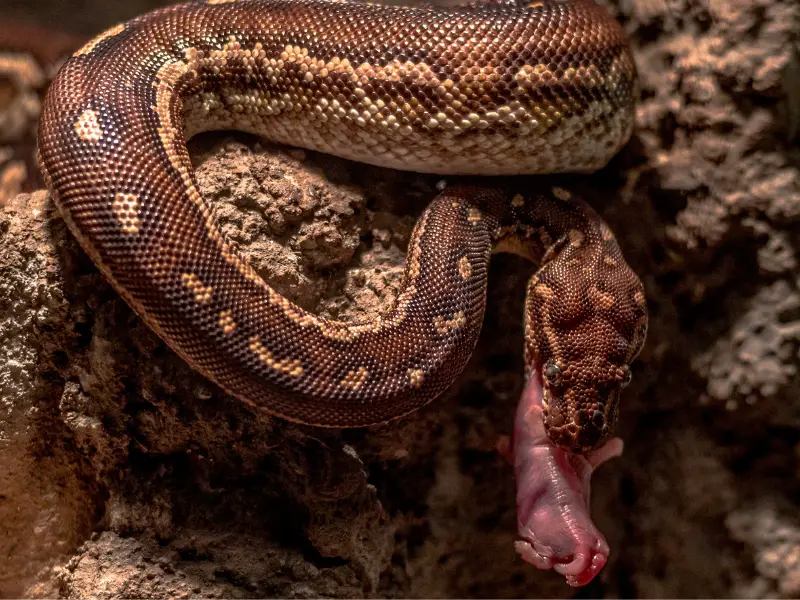
Taking care of an Angolan python in captivity is fairly simple, predictable, and straightforward, which is why this species of snake is easy to own.
This is also why Angolan pythons are a good snake for beginner reptile keepers.
As long as these snakes are properly fed, have enough space, and have the right temperatures in their enclosure, they are easy to manage.
Food And Water
Angolan pythons eat small mammals, birds, and amphibians. Most people who keep these snakes feed them rodents.
When this python is a juvenile, you can feed it one ‘appropriately sized’ rodent per week. This means the size of the rodent should not be larger than the widest point of your snake.
Start by feeding the snake mice as these are easier to digest.
As your python gets older, continue the feeding cycle of one rodent per week. Ensure that you increase the size of the rodent as your snake grows.
Some python owners feed their snakes a larger meal every 10 to 14 days, which can work. However, we recommend feeding your python more frequent, smaller meals as it better mirrors the snake’s eating habits in the wild.
As soon as these pythons are large enough, it’s a good idea to feed them rat pups instead of mice. These are better suited to the python’s diet.
If you feed the python mice, you may have to feed them in slightly larger quantities.
Angolan pythons very rarely encounter standing water in their natural habitat, so there’s no need to include a large water source.
The bowl of water you add to the enclosure is mainly for humidity as these pythons get most of their moisture from the prey they consume.
Handling
Pythons are constrictors, and they will rarely bite. They are non-venomous, which means that you can handle these snakes. Be sure to handle them carefully and slowly. Always support your snake’s weight when handling it.
Regular handling of your snake is important, as this prevents them from seeing you as a threat. If they view you as a threat, they are more likely to display aggressive behavior.
Always avoid handling these snakes for at least 24 hours after they have eaten. Otherwise, the snake could get easily stressed and react negatively to being handled.
Common Health Issues
Parasites can be a problem for any snake. Watch out for mites or ticks, which can cause a lack of appetite that can weaken your snake.
If your python has parasites, it might lie in the water to try and rid itself of them. If your snake does have parasites, you should use anthelmintics or dewormers to get rid of them.
Always have new snakes checked for parasites before bringing them home. It’s also a good idea to quarantine new snakes when you first get them.
If your python is not eating properly, it may be caused by stress, improper enclosure conditions, or an improper diet.
Breeding
It’s important to only breed Angolan pythons when they reach the appropriate size. For males, this is around 1500 grams, and for females, it is around 1800 grams.
Peak mating season for these snakes is around October.
Lower the temperature of the enclosure to stimulate mating for two weeks. Daytime temperatures should be about 78°F to 80°F during this period.
Female pythons will start nesting when pregnant, so make sure to provide a comfortable space for them to hide. A space with slightly damp moss is ideal.
Choosing And Buying An Angolan Python
Angolan pythons should always be bought from a reputable breeder. These snakes are rare, which means they are also expensive. Expect to pay around $1000 for a properly bred Angolan python.
Make sure to check your python for any parasites before bringing it home. This is most easily done with a stool sample.
An Angolan python can make a great pet for any avid snake owner. These rare snakes are beautiful to look at and are unique to keep at home.
Just make sure that your house and feed the snake correctly, and you should enjoy a long lifespan from these pythons.

